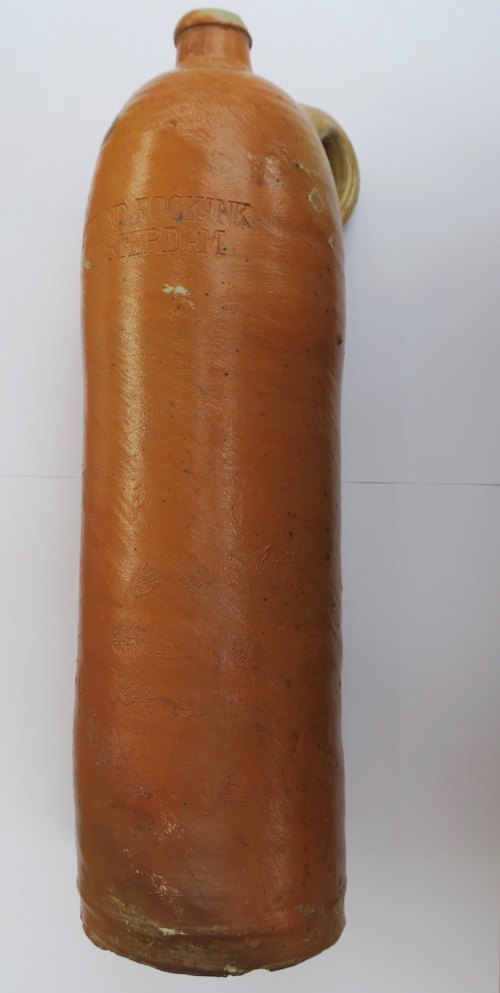
Image use policy
Our images can be used under a CC BY attribution licence (unless stated otherwise).
BOTTLE
Unique ID: MAS-D100231
Object type certainty: Certain
Workflow
status: Published ![]()
Brown ceramic bottle with a glazed surface. It was intended to contain gin of Dutch origin. The bottle measures 310 mm long and has a diameter of 85 mm with a ring type handle on the neck of the bottle. The bottle is printed with the phrase 'WYNAND FOCKINK' 'AMSTERDAM'.
In Amsterdam, Wynand Focknik has been making distinctive hand-crafted liqueurs and jenevers (Dutch gin) since 1679 (Greenberg 2012). In the 17th century, when the Dutch East Indiaman ships brought herbs, spices and sugar to Amsterdam, distillers started distilling liqueurs on a large scale. The city had become very prosperous and liqueur, contrary to beer and genever, was an expensive drink which only the rich could afford to drink on a regular basis. When in 1724 Wynand Fockink acquired the distillery and the bar in the Pijlsteeg dating back to 1679, Amsterdam was still a rich and prosperous city with a thriving liqueur industry. Under Wynand Fockink and his descendants, the liqueur distillery became one of the largest Dutch distilleries. By the end of the 18th century the company owned six large premises on the Oudezijds Voorburgwal and another six in the Pijlsteeg.
In the first decade of the 19th century the company expanded through export as well which could explain why these bottles were found on a vessel bound for Bombay. By the 19th century, Wynand Fockink owned trading houses in Berlin, Vienna, Brussels and Paris and between 1815 and 1860, France was one of the largest liqueur customers. The Wynand Fockink distillery in Amsterdam is still open today (http://wynand-fockink.nl/tasting-tavern/history).
Notes:
This item was found with four ceramic bowls (MAS-D100229), three glass bottles (MAS-D100230) and four stoneware ink bottles (MAS-D100232).
All of these items were recovered from the wreck of SS Strathclyde, a British trading steamship built in 1871 in Blackwood, Port Glasgow. The ship sank in 1876 off Dover whilst carrying 23 passengers and 47 crew for Bombay, following a collision with Franconia and resulting in the loss of 38 lives. NRHE and Kent HER reference numbers cited in this record refer to the wreck of SS Strathclyde.
Find of note status
This has been noted as an interesting find by the recorder.
Class:
Container
Sub class: Storage container. Food and liquid storage container
Inscription:
´WYNAND FOCKINK´´AMSTERDAM´
Wreck details
Droit number: 291/18
Chronology
Broad period: POST MEDIEVAL
Subperiod from: Middle
Period from: POST MEDIEVAL
Subperiod to: Late
Period to: NINETEENTH CENTURY
Dimensions and weight
Quantity: 1
Height: 310 mm
Diameter: 85 mm
Discovery dates
Date(s) of discovery: Monday 17th September 2018
Personal details
Found by: This information is restricted for your login.
Recorded by: Mr Robbie Trevelyan
Other reference numbers
NRHE monument number: 813607
Other reference: Kent HER: TR 33 NW 23
Droit ID: 291/18
Materials and construction
Primary material: Ceramic
Manufacture method: Hand made
Decoration style: Other
Completeness: Complete
Surface Treatment: Stamped
Spatial coordinates
4 Figure: TR3438
Four figure Latitude: 51.09353995
Four figure longitude: 1.34042371
1:25K map: TR3438
1:10K map: TR33NW
Display four figure position on What3Words
Unmasked grid reference accurate to a 1 metre square.
References cited
- Greenberg, P, 2012 The Best Places for Everything: The Ultimate Insider's Guide to the Greatest Experiences Around the World Pennsylvania : Rodale, ,
Similar objects

Find number: MAS-D100156
Object type: BOTTLE
Broadperiod: NINETEENTH CENTURY
Three salt glazed stoneware bottles. This form of bottle was a type used to carry seltzer water and gin.
Seltzer water was exported by vario…
Workflow: Published![]()

Find number: MAS-D100072
Object type: BOTTLE
Broadperiod: NINETEENTH CENTURY
One Hamilton bottle also known as a torpedo or egg bottle. These bottles are named after their English inventor, William Francis Hamilton who …
Workflow: Published![]()

Find number: MAS-D100040
Object type: BOTTLE
Broadperiod: POST MEDIEVAL
One onion bottle dated to c.1700.
Glass onion bottles were large hand-blown glass bottles, used aboard sailing ships to hold wine or brandy. …
Workflow: Published![]()



